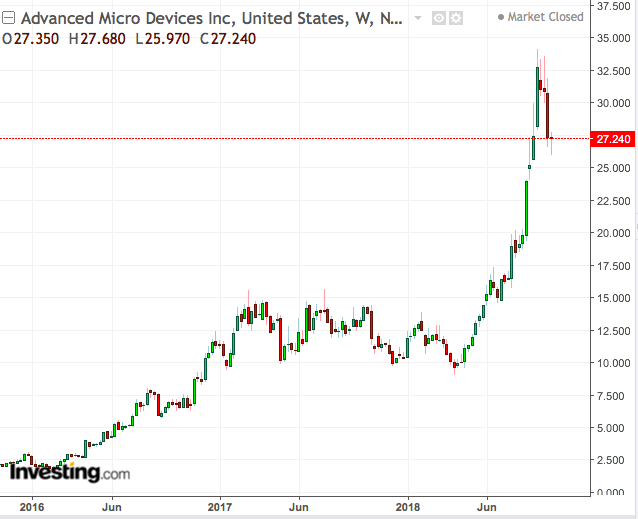After rising more than 16-fold in the past three years, shares of Advanced Micro Devices Inc. (NASDAQ:AMD) finally caved in to bearish calls. After falling about 20% from its 52-week high of $34.14, the chipmaker, which had been the best performing stock in the S&P 500 this year, is now in a bear market.

Does this dip offer a buying opportunity, or is it a sign that the rally that started in the spring of 2016 has finally run its course?
If you believe in the collective intelligence of the market then the latter is true. The majority of analysts covering AMD believe the stock is unlikely to repeat the remarkable performance of the past three years and has already seen its best days.
If history has any relevance, this conclusion seems right. AMD's past is full of missed forecasts and dismal performances. Between 2012 and 2016, the company's revenue fell more than 20%, while its adjusted EBITDA declined nearly 45%.
AMD lost a share of the market across key segments including chips for use in personal computers and graphic processing. Its market share in the PC market fell from 27.4% to 18.7%, while its server microprocessor share shrank to just 1%.
Chip Demand Is Drying Up
The semiconductor company's recent rally was mainly fueled by a demand boom coming from cryptocurrency mining. But since the crash in cryptocurrency values that started in late 2017, that demand has been drying up fast. NVIDIA Corporation (NASDAQ:NVDA), the largest maker of graphics chips for add-in cards for PCs, said in August that sales from currency miners will likely disappear entirely going forward.
Investors are also skeptical on the company’s ability to win back sales in the server chip business, which is the most lucrative segment in the chip industry. This is especially true due to reports that market leader Intel Corporation (NASDAQ:INTC) is ready to introduce new products.
AMD shares, which are currently trading at 27.240, dropped 12% in a two-day rout early this month after a research report said Intel could ramp up production of its 10-nanometer processors sooner than they originally expected. "Intel's second-half production levels suggest upside to analyst revenue estimates for the fourth quarter and first quarter of 2019," Steve Mullane, analyst BlueFin Research Partners wrote in a note on Oct. 2, according to Bloomberg.
Citing suppliers, the report said production of the processors could be pulled forward from the June 2019 timeline by four to six weeks. An additional challenge for AMD and chipmakers in general is the growing US-China trade war that has the potential to disrupt the industry.
Bottom Line
With all of these escalating concerns, we feel that the upcoming earnings report will be crucial for AMD to show that it's orchestrating a turnaround and can continue to remain relevant, despite falling demand and US-China trade war worries. For the third-quarter, AMD is expected to show an EPS of $0.11 a share on revenue of about $1.7 billion.
AMD shares will continue to remain in a highly volatile zone where the downside risk is much higher. We feel the timing is right to book profit and move to the sidelines. Rivals Intel and Nvida are much better options if you want to retain exposure to the chip sector, especially after the recent pullback in their share prices.
